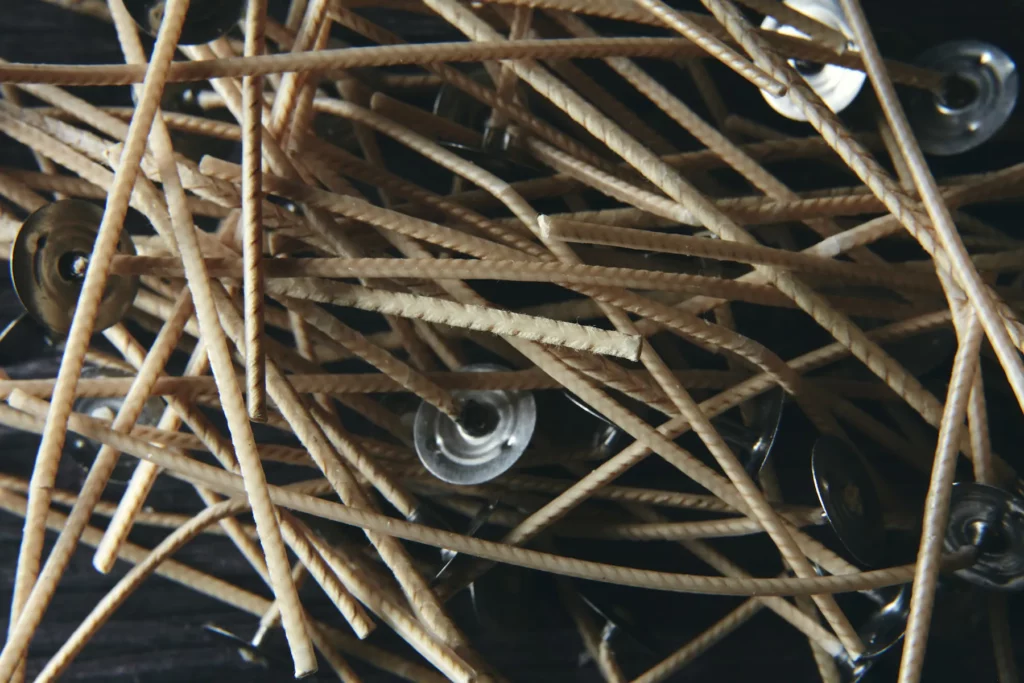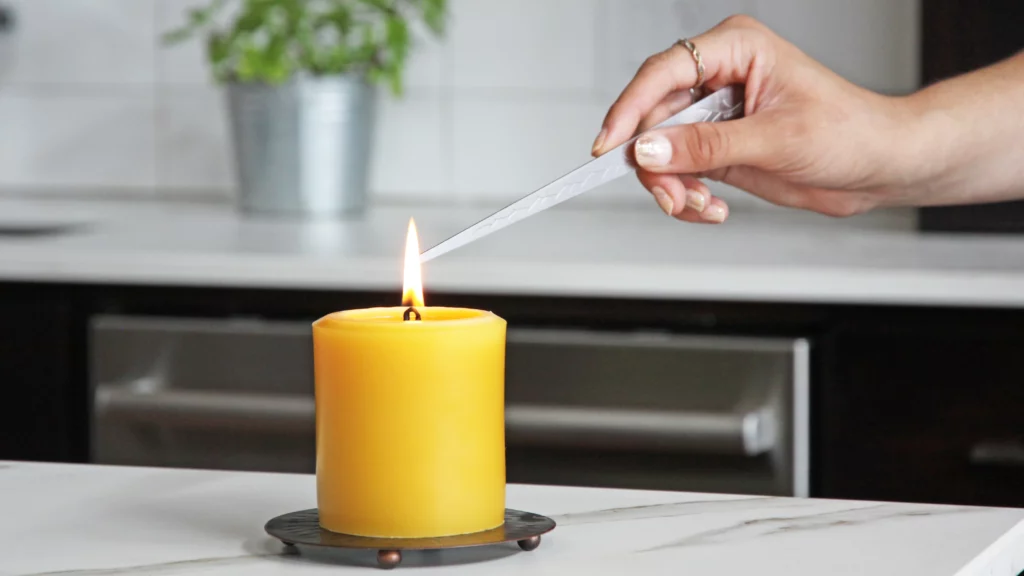Candle making is a popular hobby that allows you to create beautiful and scented candles right in the comfort of your own home. One essential component of a candle is the wick, which is responsible for providing a steady flame and ensuring an even and efficient burn. While you can easily purchase candle wicks from stores, making your own wicks at home can be a rewarding and cost-effective option. In this DIY guide, we will walk you through the process of making a candle wick from scratch, helping you understand the basics, gather the necessary materials, and take the necessary safety precautions.
Understanding the Basics of Candle Wicks
Before diving into making your own candle wick, it’s important to have a clear understanding of the role a wick plays in a candle. A wick candle serves as a pathway for the fuel (wax or oil) to travel to the flame. It is responsible for drawing up the fuel and vaporizing it, which in turn creates the flame. The size and structure of the wick greatly influence the candle’s burn time, the size of the flame, and the overall performance of the candle. Therefore, choosing the right wick and properly preparing it is crucial for achieving optimal results in your candle making endeavors.
Importance of a Good Candle Wick
A good candle wick ensures that the fuel is consumed efficiently, without excessive smoke, soot, or tunneling. The choice of wick largely depends on the type of candle you are making, the size of the container or mold, and the type of wax or oil you are using. By making your own candle wick, you have the flexibility to customize the size and material, allowing for better control over the burning characteristics of your candle.
Different Types of Candle Wicks
When it comes to candle wicks, there are various types available in the market. Cotton wicks are the most common and versatile option, as they work well with different types of waxes and oils. Other options include zinc wicks, which are pre-coated with wax, and wooden wicks, which provide a unique crackling sound as they burn. Each type of wick has its own set of advantages and considerations, so it’s important to choose the one that best suits your specific candle making needs.
Let’s delve deeper into the world of cotton wicks. Cotton wicks are widely used due to their excellent burn characteristics. They are known for their ability to provide a steady and consistent flame, ensuring an even burn throughout the candle’s lifespan. Cotton wicks are also known for their minimal mushrooming, which refers to the carbon buildup at the tip of the wick. This helps to reduce soot and smoke, resulting in a cleaner burning candle.
On the other hand, zinc wicks offer their own unique advantages. These wicks are pre-coated with wax, which helps to enhance their performance. The wax coating provides a more controlled and efficient fuel consumption, resulting in a longer burn time. Additionally, zinc wicks are known for their ability to resist mushrooming, making them a popular choice for container candles.
Gathering Your Materials
Now that you have a good understanding of candle wicks, it’s time to gather the necessary materials for making your own. Here’s a list of essential supplies you’ll need:
- A ball of cotton string
- A pair of scissors
- A candle wick sustainer
- A double boiler
- A heat-resistant container
- A wax or oil of your choice
Before you begin the candle-making process, it’s crucial to ensure that you have a clean and organized workspace. Clear a flat surface and gather all your materials within easy reach. Having everything prepared beforehand will make the crafting experience more enjoyable and efficient.
Additionally, consider the ambiance you want to create with your candles. Are you aiming for a calming, aromatic atmosphere or a bright and invigorating one? Your choice of wax or oil will play a significant role in achieving the desired effect. Be sure to select a high-quality wax or oil that aligns with your scent preferences and intended use for the candles.

Choosing the Right Type of String
When it comes to selecting the string for your wick, it’s important to choose a material that is compatible with your chosen fuel. Cotton string works well with most types of waxes and oils, making it a safe and reliable choice. Make sure to select a lightweight, tightly twisted cotton string that will create a stable flame when properly prepared and used.
For those looking to add a decorative touch to their candles, consider experimenting with different colors or patterns of cotton string. This can elevate the visual appeal of your candles and make them stand out as unique creations. Remember to test the burn quality of the colored strings to ensure they perform just as well as traditional white ones.
Preparing Your Wick
Preparing your wick is an important step that ensures optimal burning performance. Follow these steps to prepare your cotton string:
Before we dive into the detailed steps of preparing your wick, let’s understand the significance of this process. A well-prepared wick is crucial for a clean and consistent burn in your candle. It helps in controlling the rate at which the wax is consumed and plays a key role in preventing issues like tunneling or soot build-up. By taking the time to properly prepare your wick, you are setting the foundation for a successful and enjoyable burning experience.
Cutting the String to the Right Length
Start by determining the desired length of your wick. This will depend on the size of your candle container or mold. Use a pair of scissors to cut the cotton string to the appropriate length, leaving a few extra inches for attaching the wick sustainer.
When cutting the wick, it’s essential to ensure that it is neither too short nor too long for the container. A wick that is too short might get drowned in the wax, leading to an inefficient burn, while a wick that is too long can cause excessive flickering and sooting. Finding the right balance is key to achieving an optimal burn for your candle.
Treating the String for Better Burning
Before proceeding to make the actual wick, it’s important to treat the cotton string to improve its burning characteristics. One effective method is to soak the string in a solution of boric acid and salt. This solution helps prevent excessive smoking and maximizes the fuel absorption of the wick. After soaking the string, let it dry completely before moving on.
The boric acid and salt solution not only aids in creating a more stable and cleaner burn but also helps in reducing mushrooming at the tip of the wick. This treatment process is especially beneficial for natural cotton wicks, as it enhances their performance and prolongs the overall burn time of the candle. Taking the extra step to treat your wick demonstrates your commitment to crafting high-quality candles with excellent burning properties.

Making the Candle Wick
Once your cotton string is cut and treated, you’re ready to make your own candle wick. Follow these steps:
Creating a candle wick can be a rewarding and essential part of candle making. It ensures that your candle burns evenly and efficiently, providing a warm and comforting glow. By crafting your own wick, you have control over its quality and can customize it to suit your specific candle-making needs.
Steps to Create Your Own Candle Wick
1. Thread one end of the string through the wick sustainer, leaving a loop at the opposite end.
2. Pull the string until the sustainer rests snugly against the looped end.
3. Use pliers to crimp the sustainer, securing the looped end of the string in place.
4. Trim any excess string, leaving about half an inch extending beyond the crimped sustainer.
Once you have completed these steps, you will have a well-crafted candle wick ready to be placed in your candle container or mold. The process of making your own wick adds a personal touch to your candles and can enhance the overall candle-making experience.
Tips for Ensuring a Long-Lasting Wick
To ensure your homemade wick performs optimally, consider the following tips:
- Trim the wick to an appropriate length before each use.
- Avoid exposing the wick to drafts or strong air currents.
- Allow the candle to burn long enough for a full melt pool to form.
- Monitor the candle’s burn and adjust the wick size if necessary.
Proper wick maintenance is crucial for the longevity and quality of your candle. By following these tips, you can maximize the burn time of your candles and ensure a consistent and beautiful flame. Remember, the wick is the heart of the candle, so taking care of it will result in a more enjoyable and fulfilling candle-burning experience.
Safety Precautions When Making and Using Homemade Wicks
When working with candles and homemade wicks, it’s important to prioritize safety. Here are a few precautions to keep in mind:
Avoiding Common Candle Wick Mistakes
Be aware of common mistakes that can affect the performance of your homemade wicks, such as using a wick that is too small for the container size, or using a wick that is not properly treated or primed.
Choosing the right wick size is crucial for a successful candle-making experience. A wick that is too small may result in an uneven burn, tunneling, or extinguishing itself prematurely. On the other hand, a wick that is too large can cause excessive smoking, soot buildup, and even safety hazards. It’s essential to match the wick size to the diameter of your candle container to achieve optimal burning performance.
Proper Use and Maintenance of Your DIY Wick
Always follow proper candle safety guidelines when using your DIY wicks. Never leave a burning candle unattended and keep it away from flammable objects. Additionally, regularly monitor the performance of your wick and make adjustments as needed to ensure safe and efficient burning.
Ensuring the proper maintenance of your DIY wick is key to extending the life of your candles. Trimming the wick to the recommended length before each use helps prevent mushrooming, soot buildup, and uneven burning. It’s also important to keep the wax pool free of debris to maintain a clean and consistent burn. By taking these simple steps, you can enjoy a longer-lasting and more fragrant candle experience.
By making your own candle wick, you have the opportunity to tailor the wick to your specific candle making needs, resulting in a beautifully burning candle. Remember to gather all the necessary materials, follow the steps carefully, and prioritize safety throughout the process. With a little practice and experimentation, you’ll soon be creating homemade candles that not only look and smell amazing but also burn beautifully.
More to read: Creating Ambiance with a Luxurious 3 Wick Candle
